Critical Evaluation of Hand Hygiene Audit Report: Royal Berkshire NHS
VerifiedAdded on 2023/01/11
|21
|8537
|88
Report
AI Summary
This report critically evaluates the role of hand hygiene audit reports in measuring overall compliance scores within the healthcare system, using the Royal Berkshire NHS as a case study. The study explores the background and rationale for hand hygiene audits, emphasizing their significance in preventing the spread of infection among healthcare workers and patients. The research methodology includes an examination of the five moments of hand hygiene and the use of digital software for data reporting. The report delves into the impact of change and the importance of leadership in promoting hand hygiene practices. It also identifies key challenges associated with hand hygiene audits and provides reflective commentary on the findings. The report aims to develop an understanding of hand hygiene audit reports, identify how they measure compliance scores, and determine the associated challenges. The study highlights the importance of hand hygiene for maintaining a safe and clean working environment, promoting health and safety, and building trust with patients. The report concludes by summarizing the key findings and their implications for improving hand hygiene practices within healthcare settings.
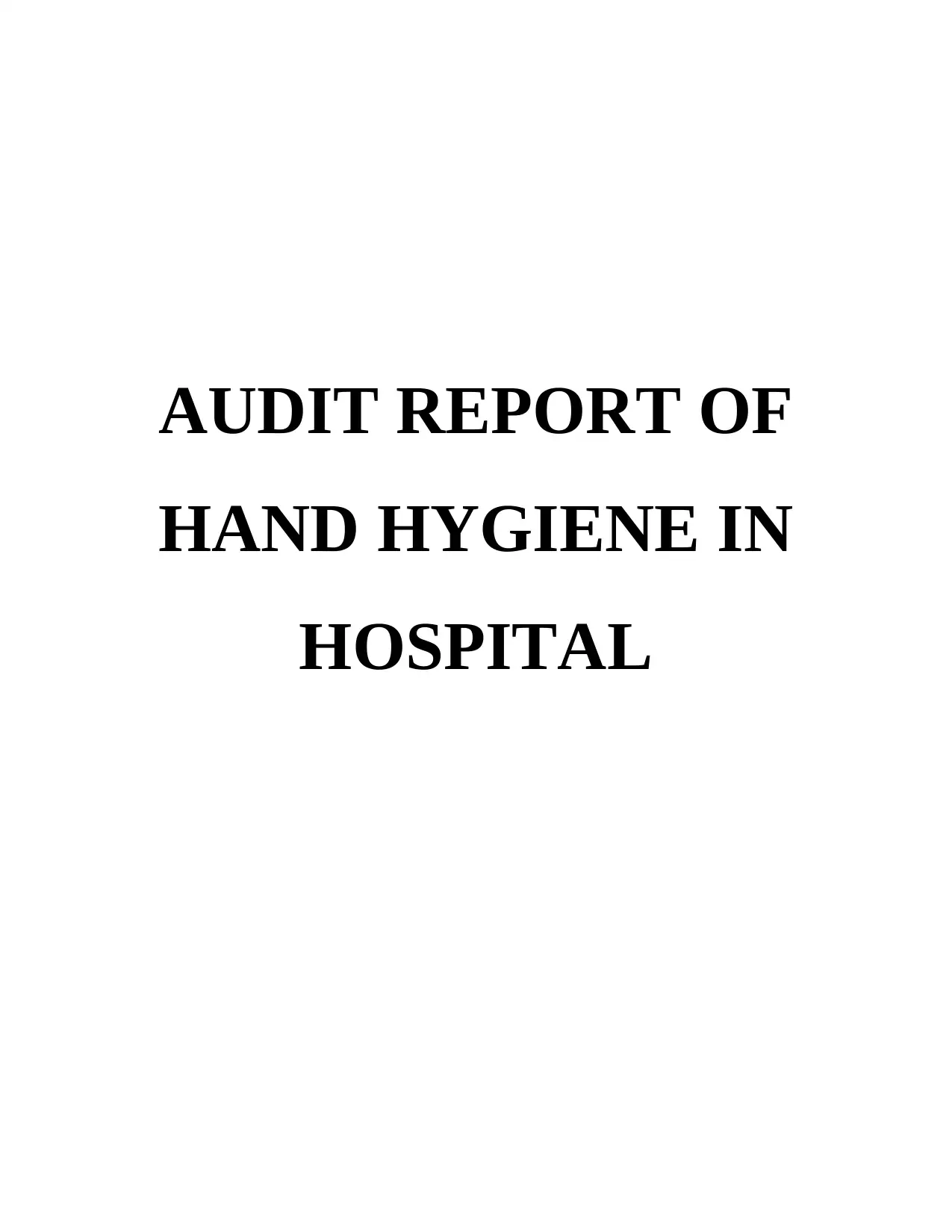
AUDIT REPORT OF
HAND HYGIENE IN
HOSPITAL
HAND HYGIENE IN
HOSPITAL
Paraphrase This Document
Need a fresh take? Get an instant paraphrase of this document with our AI Paraphraser
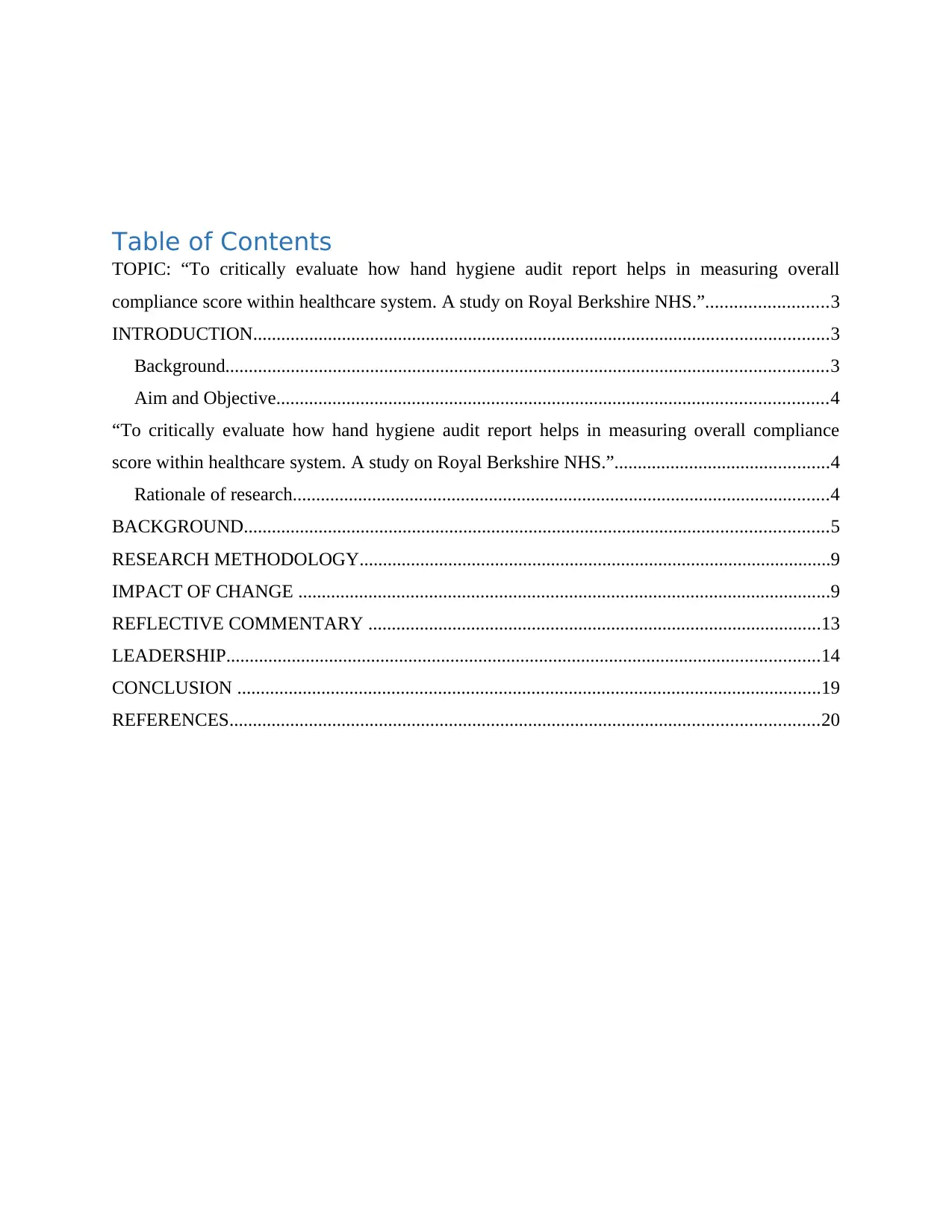
Table of Contents
TOPIC: “To critically evaluate how hand hygiene audit report helps in measuring overall
compliance score within healthcare system. A study on Royal Berkshire NHS.”..........................3
INTRODUCTION...........................................................................................................................3
Background.................................................................................................................................3
Aim and Objective......................................................................................................................4
“To critically evaluate how hand hygiene audit report helps in measuring overall compliance
score within healthcare system. A study on Royal Berkshire NHS.”..............................................4
Rationale of research...................................................................................................................4
BACKGROUND.............................................................................................................................5
RESEARCH METHODOLOGY.....................................................................................................9
IMPACT OF CHANGE ..................................................................................................................9
REFLECTIVE COMMENTARY .................................................................................................13
LEADERSHIP...............................................................................................................................14
CONCLUSION .............................................................................................................................19
REFERENCES..............................................................................................................................20
TOPIC: “To critically evaluate how hand hygiene audit report helps in measuring overall
compliance score within healthcare system. A study on Royal Berkshire NHS.”..........................3
INTRODUCTION...........................................................................................................................3
Background.................................................................................................................................3
Aim and Objective......................................................................................................................4
“To critically evaluate how hand hygiene audit report helps in measuring overall compliance
score within healthcare system. A study on Royal Berkshire NHS.”..............................................4
Rationale of research...................................................................................................................4
BACKGROUND.............................................................................................................................5
RESEARCH METHODOLOGY.....................................................................................................9
IMPACT OF CHANGE ..................................................................................................................9
REFLECTIVE COMMENTARY .................................................................................................13
LEADERSHIP...............................................................................................................................14
CONCLUSION .............................................................................................................................19
REFERENCES..............................................................................................................................20
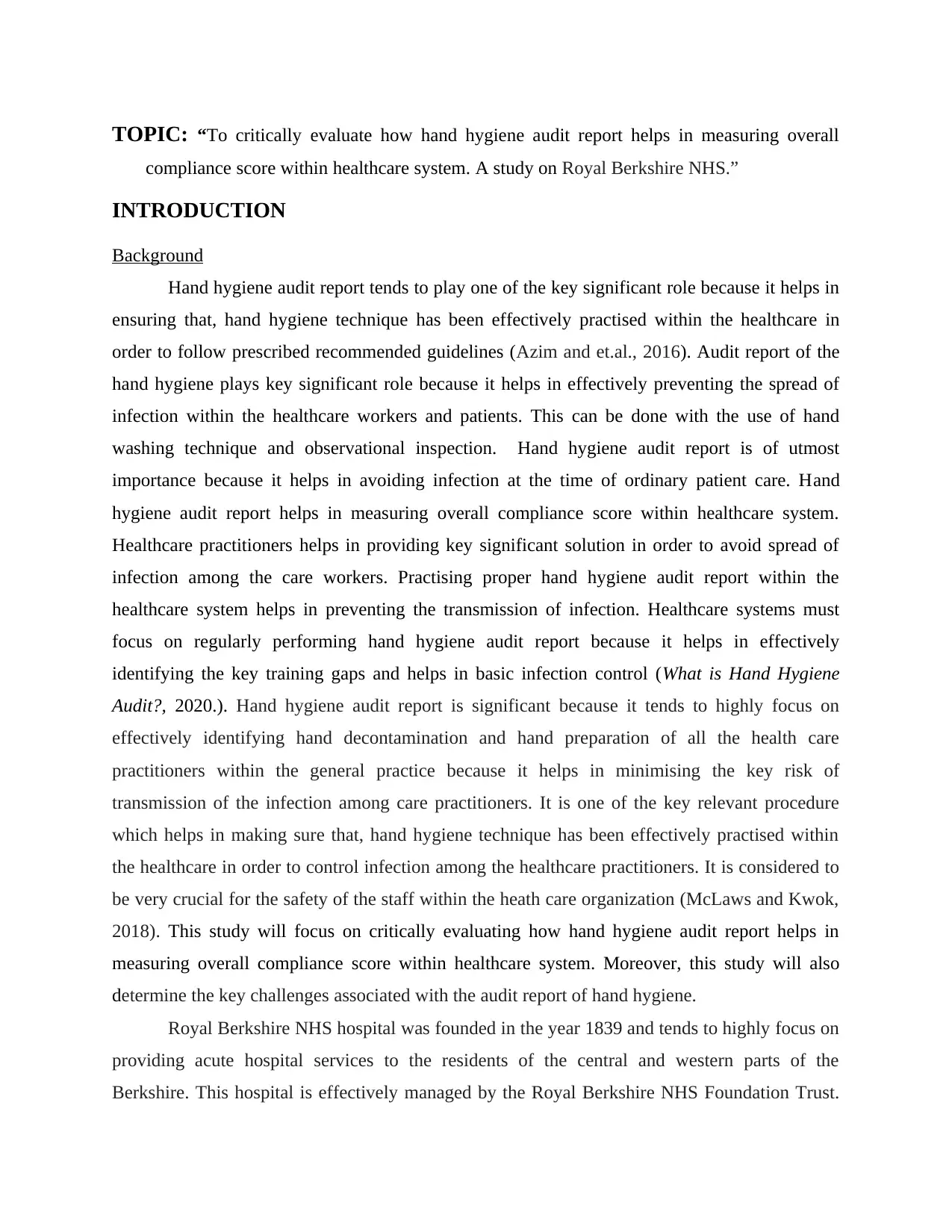
TOPIC: “To critically evaluate how hand hygiene audit report helps in measuring overall
compliance score within healthcare system. A study on Royal Berkshire NHS.”
INTRODUCTION
Background
Hand hygiene audit report tends to play one of the key significant role because it helps in
ensuring that, hand hygiene technique has been effectively practised within the healthcare in
order to follow prescribed recommended guidelines (Azim and et.al., 2016). Audit report of the
hand hygiene plays key significant role because it helps in effectively preventing the spread of
infection within the healthcare workers and patients. This can be done with the use of hand
washing technique and observational inspection. Hand hygiene audit report is of utmost
importance because it helps in avoiding infection at the time of ordinary patient care. Hand
hygiene audit report helps in measuring overall compliance score within healthcare system.
Healthcare practitioners helps in providing key significant solution in order to avoid spread of
infection among the care workers. Practising proper hand hygiene audit report within the
healthcare system helps in preventing the transmission of infection. Healthcare systems must
focus on regularly performing hand hygiene audit report because it helps in effectively
identifying the key training gaps and helps in basic infection control (What is Hand Hygiene
Audit?, 2020.). Hand hygiene audit report is significant because it tends to highly focus on
effectively identifying hand decontamination and hand preparation of all the health care
practitioners within the general practice because it helps in minimising the key risk of
transmission of the infection among care practitioners. It is one of the key relevant procedure
which helps in making sure that, hand hygiene technique has been effectively practised within
the healthcare in order to control infection among the healthcare practitioners. It is considered to
be very crucial for the safety of the staff within the heath care organization (McLaws and Kwok,
2018). This study will focus on critically evaluating how hand hygiene audit report helps in
measuring overall compliance score within healthcare system. Moreover, this study will also
determine the key challenges associated with the audit report of hand hygiene.
Royal Berkshire NHS hospital was founded in the year 1839 and tends to highly focus on
providing acute hospital services to the residents of the central and western parts of the
Berkshire. This hospital is effectively managed by the Royal Berkshire NHS Foundation Trust.
compliance score within healthcare system. A study on Royal Berkshire NHS.”
INTRODUCTION
Background
Hand hygiene audit report tends to play one of the key significant role because it helps in
ensuring that, hand hygiene technique has been effectively practised within the healthcare in
order to follow prescribed recommended guidelines (Azim and et.al., 2016). Audit report of the
hand hygiene plays key significant role because it helps in effectively preventing the spread of
infection within the healthcare workers and patients. This can be done with the use of hand
washing technique and observational inspection. Hand hygiene audit report is of utmost
importance because it helps in avoiding infection at the time of ordinary patient care. Hand
hygiene audit report helps in measuring overall compliance score within healthcare system.
Healthcare practitioners helps in providing key significant solution in order to avoid spread of
infection among the care workers. Practising proper hand hygiene audit report within the
healthcare system helps in preventing the transmission of infection. Healthcare systems must
focus on regularly performing hand hygiene audit report because it helps in effectively
identifying the key training gaps and helps in basic infection control (What is Hand Hygiene
Audit?, 2020.). Hand hygiene audit report is significant because it tends to highly focus on
effectively identifying hand decontamination and hand preparation of all the health care
practitioners within the general practice because it helps in minimising the key risk of
transmission of the infection among care practitioners. It is one of the key relevant procedure
which helps in making sure that, hand hygiene technique has been effectively practised within
the healthcare in order to control infection among the healthcare practitioners. It is considered to
be very crucial for the safety of the staff within the heath care organization (McLaws and Kwok,
2018). This study will focus on critically evaluating how hand hygiene audit report helps in
measuring overall compliance score within healthcare system. Moreover, this study will also
determine the key challenges associated with the audit report of hand hygiene.
Royal Berkshire NHS hospital was founded in the year 1839 and tends to highly focus on
providing acute hospital services to the residents of the central and western parts of the
Berkshire. This hospital is effectively managed by the Royal Berkshire NHS Foundation Trust.
⊘ This is a preview!⊘
Do you want full access?
Subscribe today to unlock all pages.

Trusted by 1+ million students worldwide
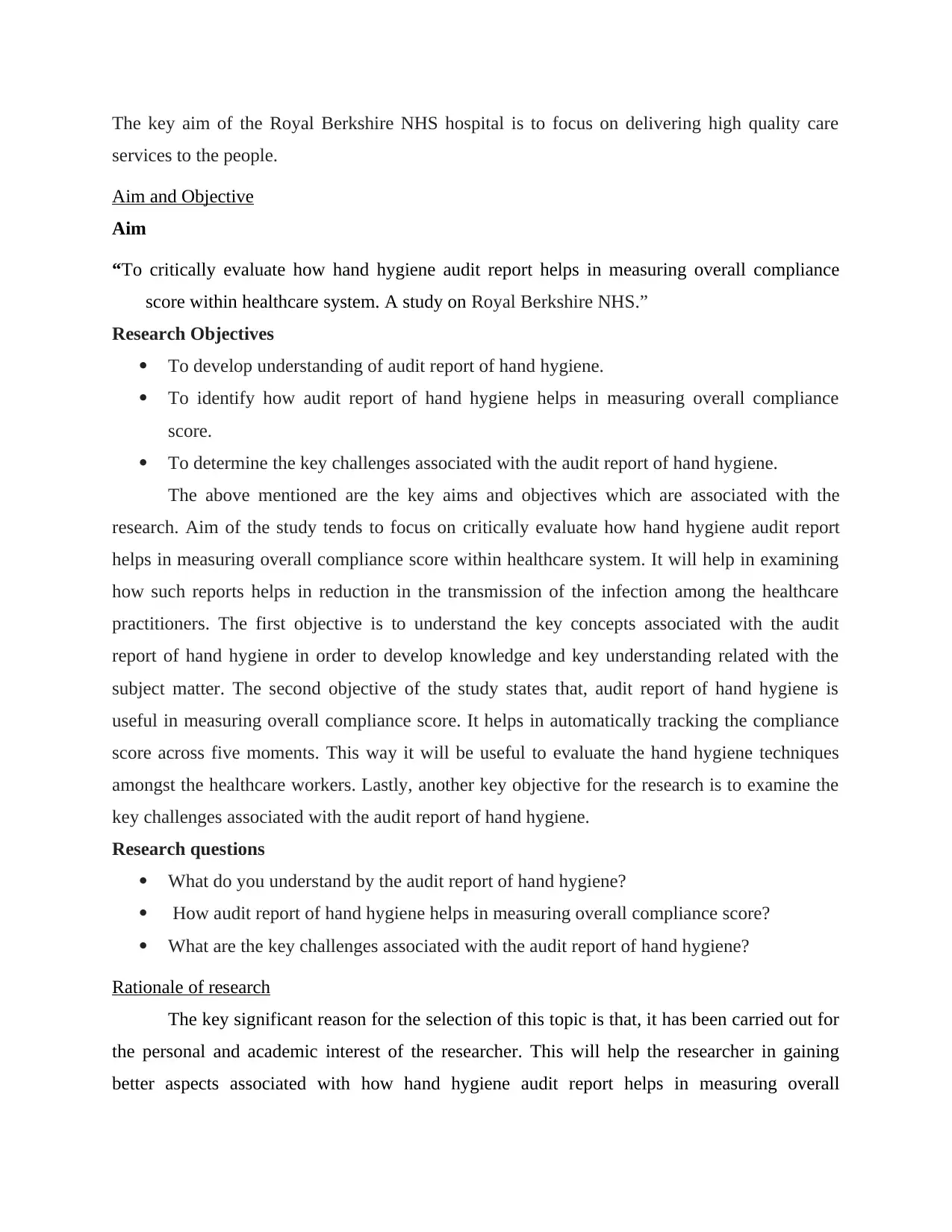
The key aim of the Royal Berkshire NHS hospital is to focus on delivering high quality care
services to the people.
Aim and Objective
Aim
“To critically evaluate how hand hygiene audit report helps in measuring overall compliance
score within healthcare system. A study on Royal Berkshire NHS.”
Research Objectives
To develop understanding of audit report of hand hygiene.
To identify how audit report of hand hygiene helps in measuring overall compliance
score.
To determine the key challenges associated with the audit report of hand hygiene.
The above mentioned are the key aims and objectives which are associated with the
research. Aim of the study tends to focus on critically evaluate how hand hygiene audit report
helps in measuring overall compliance score within healthcare system. It will help in examining
how such reports helps in reduction in the transmission of the infection among the healthcare
practitioners. The first objective is to understand the key concepts associated with the audit
report of hand hygiene in order to develop knowledge and key understanding related with the
subject matter. The second objective of the study states that, audit report of hand hygiene is
useful in measuring overall compliance score. It helps in automatically tracking the compliance
score across five moments. This way it will be useful to evaluate the hand hygiene techniques
amongst the healthcare workers. Lastly, another key objective for the research is to examine the
key challenges associated with the audit report of hand hygiene.
Research questions
What do you understand by the audit report of hand hygiene?
How audit report of hand hygiene helps in measuring overall compliance score?
What are the key challenges associated with the audit report of hand hygiene?
Rationale of research
The key significant reason for the selection of this topic is that, it has been carried out for
the personal and academic interest of the researcher. This will help the researcher in gaining
better aspects associated with how hand hygiene audit report helps in measuring overall
services to the people.
Aim and Objective
Aim
“To critically evaluate how hand hygiene audit report helps in measuring overall compliance
score within healthcare system. A study on Royal Berkshire NHS.”
Research Objectives
To develop understanding of audit report of hand hygiene.
To identify how audit report of hand hygiene helps in measuring overall compliance
score.
To determine the key challenges associated with the audit report of hand hygiene.
The above mentioned are the key aims and objectives which are associated with the
research. Aim of the study tends to focus on critically evaluate how hand hygiene audit report
helps in measuring overall compliance score within healthcare system. It will help in examining
how such reports helps in reduction in the transmission of the infection among the healthcare
practitioners. The first objective is to understand the key concepts associated with the audit
report of hand hygiene in order to develop knowledge and key understanding related with the
subject matter. The second objective of the study states that, audit report of hand hygiene is
useful in measuring overall compliance score. It helps in automatically tracking the compliance
score across five moments. This way it will be useful to evaluate the hand hygiene techniques
amongst the healthcare workers. Lastly, another key objective for the research is to examine the
key challenges associated with the audit report of hand hygiene.
Research questions
What do you understand by the audit report of hand hygiene?
How audit report of hand hygiene helps in measuring overall compliance score?
What are the key challenges associated with the audit report of hand hygiene?
Rationale of research
The key significant reason for the selection of this topic is that, it has been carried out for
the personal and academic interest of the researcher. This will help the researcher in gaining
better aspects associated with how hand hygiene audit report helps in measuring overall
Paraphrase This Document
Need a fresh take? Get an instant paraphrase of this document with our AI Paraphraser
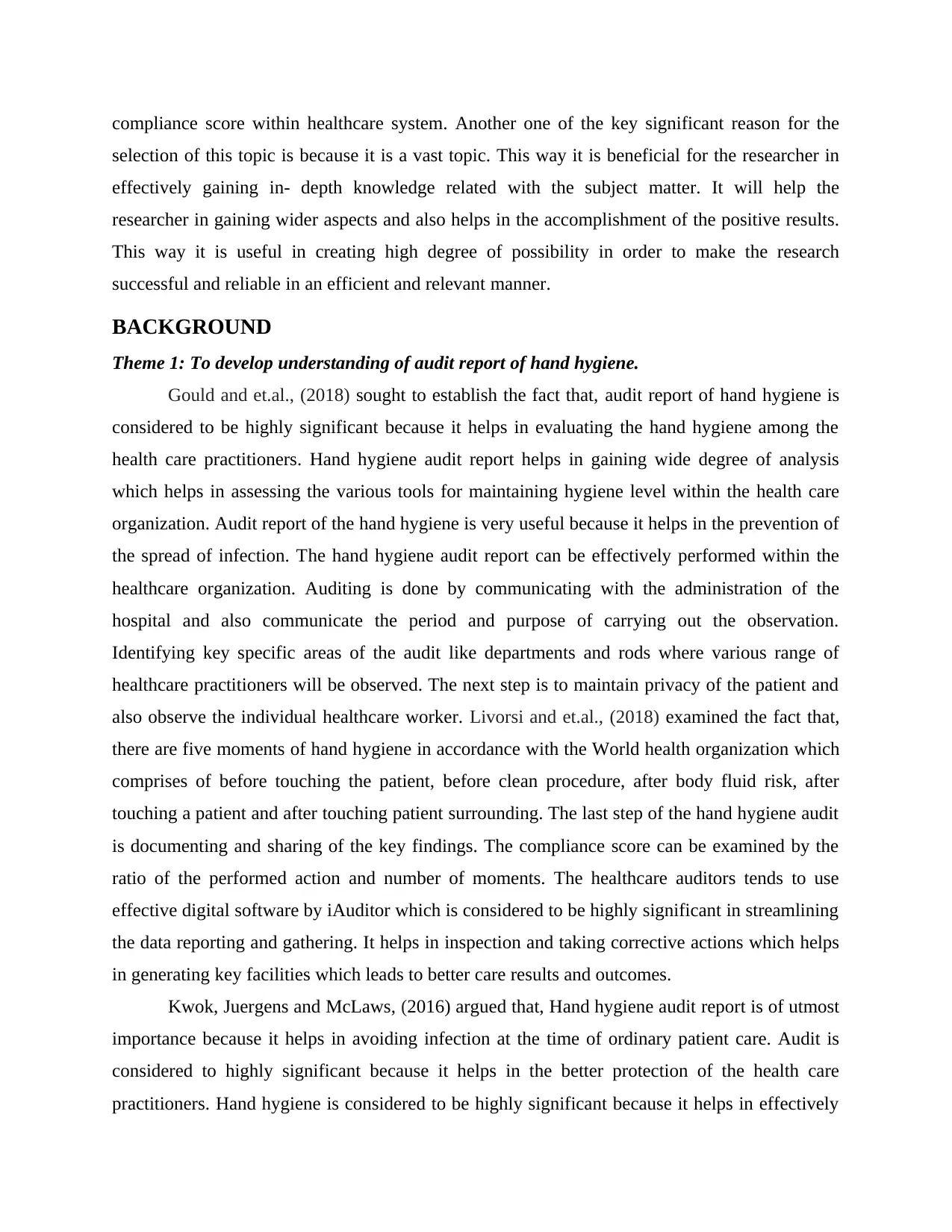
compliance score within healthcare system. Another one of the key significant reason for the
selection of this topic is because it is a vast topic. This way it is beneficial for the researcher in
effectively gaining in- depth knowledge related with the subject matter. It will help the
researcher in gaining wider aspects and also helps in the accomplishment of the positive results.
This way it is useful in creating high degree of possibility in order to make the research
successful and reliable in an efficient and relevant manner.
BACKGROUND
Theme 1: To develop understanding of audit report of hand hygiene.
Gould and et.al., (2018) sought to establish the fact that, audit report of hand hygiene is
considered to be highly significant because it helps in evaluating the hand hygiene among the
health care practitioners. Hand hygiene audit report helps in gaining wide degree of analysis
which helps in assessing the various tools for maintaining hygiene level within the health care
organization. Audit report of the hand hygiene is very useful because it helps in the prevention of
the spread of infection. The hand hygiene audit report can be effectively performed within the
healthcare organization. Auditing is done by communicating with the administration of the
hospital and also communicate the period and purpose of carrying out the observation.
Identifying key specific areas of the audit like departments and rods where various range of
healthcare practitioners will be observed. The next step is to maintain privacy of the patient and
also observe the individual healthcare worker. Livorsi and et.al., (2018) examined the fact that,
there are five moments of hand hygiene in accordance with the World health organization which
comprises of before touching the patient, before clean procedure, after body fluid risk, after
touching a patient and after touching patient surrounding. The last step of the hand hygiene audit
is documenting and sharing of the key findings. The compliance score can be examined by the
ratio of the performed action and number of moments. The healthcare auditors tends to use
effective digital software by iAuditor which is considered to be highly significant in streamlining
the data reporting and gathering. It helps in inspection and taking corrective actions which helps
in generating key facilities which leads to better care results and outcomes.
Kwok, Juergens and McLaws, (2016) argued that, Hand hygiene audit report is of utmost
importance because it helps in avoiding infection at the time of ordinary patient care. Audit is
considered to highly significant because it helps in the better protection of the health care
practitioners. Hand hygiene is considered to be highly significant because it helps in effectively
selection of this topic is because it is a vast topic. This way it is beneficial for the researcher in
effectively gaining in- depth knowledge related with the subject matter. It will help the
researcher in gaining wider aspects and also helps in the accomplishment of the positive results.
This way it is useful in creating high degree of possibility in order to make the research
successful and reliable in an efficient and relevant manner.
BACKGROUND
Theme 1: To develop understanding of audit report of hand hygiene.
Gould and et.al., (2018) sought to establish the fact that, audit report of hand hygiene is
considered to be highly significant because it helps in evaluating the hand hygiene among the
health care practitioners. Hand hygiene audit report helps in gaining wide degree of analysis
which helps in assessing the various tools for maintaining hygiene level within the health care
organization. Audit report of the hand hygiene is very useful because it helps in the prevention of
the spread of infection. The hand hygiene audit report can be effectively performed within the
healthcare organization. Auditing is done by communicating with the administration of the
hospital and also communicate the period and purpose of carrying out the observation.
Identifying key specific areas of the audit like departments and rods where various range of
healthcare practitioners will be observed. The next step is to maintain privacy of the patient and
also observe the individual healthcare worker. Livorsi and et.al., (2018) examined the fact that,
there are five moments of hand hygiene in accordance with the World health organization which
comprises of before touching the patient, before clean procedure, after body fluid risk, after
touching a patient and after touching patient surrounding. The last step of the hand hygiene audit
is documenting and sharing of the key findings. The compliance score can be examined by the
ratio of the performed action and number of moments. The healthcare auditors tends to use
effective digital software by iAuditor which is considered to be highly significant in streamlining
the data reporting and gathering. It helps in inspection and taking corrective actions which helps
in generating key facilities which leads to better care results and outcomes.
Kwok, Juergens and McLaws, (2016) argued that, Hand hygiene audit report is of utmost
importance because it helps in avoiding infection at the time of ordinary patient care. Audit is
considered to highly significant because it helps in the better protection of the health care
practitioners. Hand hygiene is considered to be highly significant because it helps in effectively
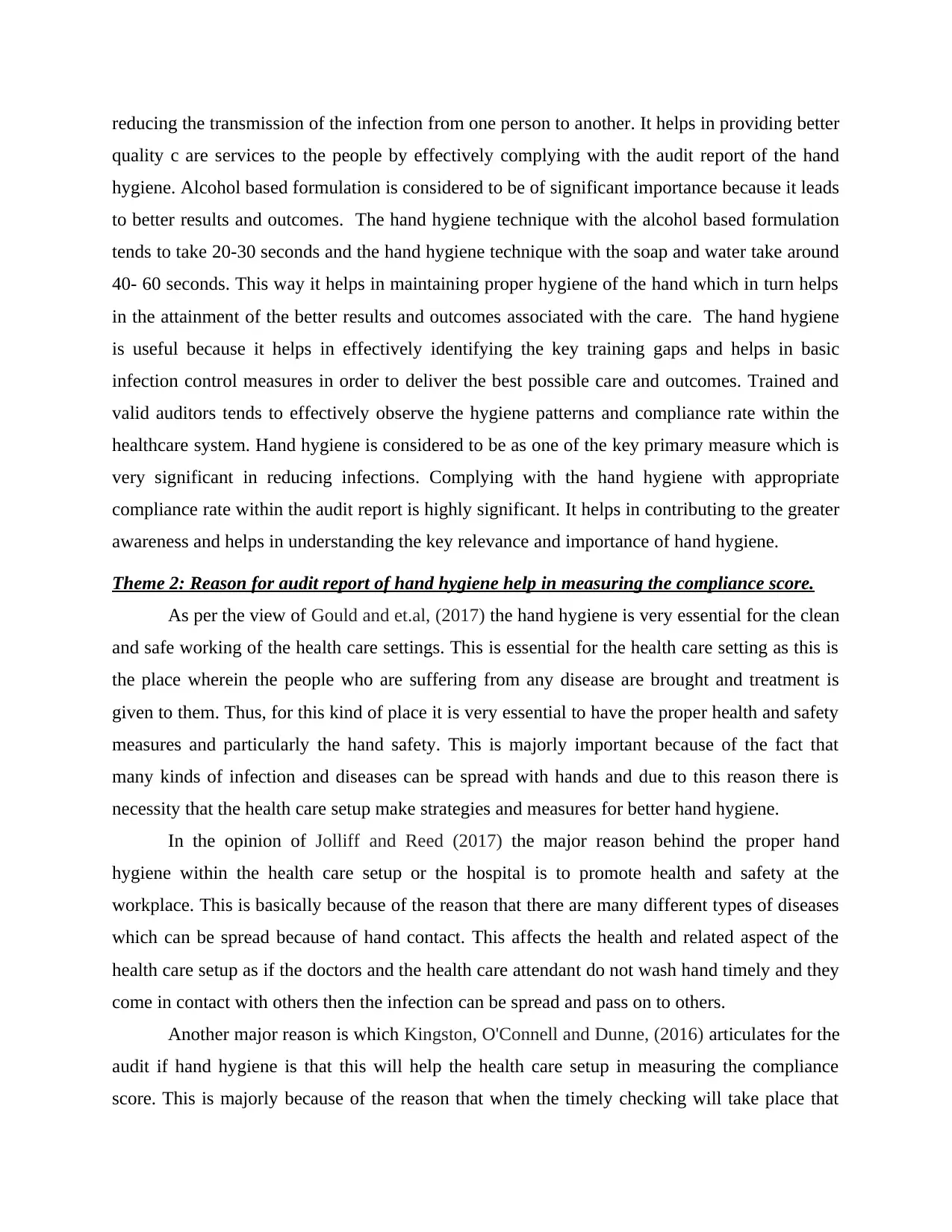
reducing the transmission of the infection from one person to another. It helps in providing better
quality c are services to the people by effectively complying with the audit report of the hand
hygiene. Alcohol based formulation is considered to be of significant importance because it leads
to better results and outcomes. The hand hygiene technique with the alcohol based formulation
tends to take 20-30 seconds and the hand hygiene technique with the soap and water take around
40- 60 seconds. This way it helps in maintaining proper hygiene of the hand which in turn helps
in the attainment of the better results and outcomes associated with the care. The hand hygiene
is useful because it helps in effectively identifying the key training gaps and helps in basic
infection control measures in order to deliver the best possible care and outcomes. Trained and
valid auditors tends to effectively observe the hygiene patterns and compliance rate within the
healthcare system. Hand hygiene is considered to be as one of the key primary measure which is
very significant in reducing infections. Complying with the hand hygiene with appropriate
compliance rate within the audit report is highly significant. It helps in contributing to the greater
awareness and helps in understanding the key relevance and importance of hand hygiene.
Theme 2: Reason for audit report of hand hygiene help in measuring the compliance score.
As per the view of Gould and et.al, (2017) the hand hygiene is very essential for the clean
and safe working of the health care settings. This is essential for the health care setting as this is
the place wherein the people who are suffering from any disease are brought and treatment is
given to them. Thus, for this kind of place it is very essential to have the proper health and safety
measures and particularly the hand safety. This is majorly important because of the fact that
many kinds of infection and diseases can be spread with hands and due to this reason there is
necessity that the health care setup make strategies and measures for better hand hygiene.
In the opinion of Jolliff and Reed (2017) the major reason behind the proper hand
hygiene within the health care setup or the hospital is to promote health and safety at the
workplace. This is basically because of the reason that there are many different types of diseases
which can be spread because of hand contact. This affects the health and related aspect of the
health care setup as if the doctors and the health care attendant do not wash hand timely and they
come in contact with others then the infection can be spread and pass on to others.
Another major reason is which Kingston, O'Connell and Dunne, (2016) articulates for the
audit if hand hygiene is that this will help the health care setup in measuring the compliance
score. This is majorly because of the reason that when the timely checking will take place that
quality c are services to the people by effectively complying with the audit report of the hand
hygiene. Alcohol based formulation is considered to be of significant importance because it leads
to better results and outcomes. The hand hygiene technique with the alcohol based formulation
tends to take 20-30 seconds and the hand hygiene technique with the soap and water take around
40- 60 seconds. This way it helps in maintaining proper hygiene of the hand which in turn helps
in the attainment of the better results and outcomes associated with the care. The hand hygiene
is useful because it helps in effectively identifying the key training gaps and helps in basic
infection control measures in order to deliver the best possible care and outcomes. Trained and
valid auditors tends to effectively observe the hygiene patterns and compliance rate within the
healthcare system. Hand hygiene is considered to be as one of the key primary measure which is
very significant in reducing infections. Complying with the hand hygiene with appropriate
compliance rate within the audit report is highly significant. It helps in contributing to the greater
awareness and helps in understanding the key relevance and importance of hand hygiene.
Theme 2: Reason for audit report of hand hygiene help in measuring the compliance score.
As per the view of Gould and et.al, (2017) the hand hygiene is very essential for the clean
and safe working of the health care settings. This is essential for the health care setting as this is
the place wherein the people who are suffering from any disease are brought and treatment is
given to them. Thus, for this kind of place it is very essential to have the proper health and safety
measures and particularly the hand safety. This is majorly important because of the fact that
many kinds of infection and diseases can be spread with hands and due to this reason there is
necessity that the health care setup make strategies and measures for better hand hygiene.
In the opinion of Jolliff and Reed (2017) the major reason behind the proper hand
hygiene within the health care setup or the hospital is to promote health and safety at the
workplace. This is basically because of the reason that there are many different types of diseases
which can be spread because of hand contact. This affects the health and related aspect of the
health care setup as if the doctors and the health care attendant do not wash hand timely and they
come in contact with others then the infection can be spread and pass on to others.
Another major reason is which Kingston, O'Connell and Dunne, (2016) articulates for the
audit if hand hygiene is that this will help the health care setup in measuring the compliance
score. This is majorly because of the reason that when the timely checking will take place that
⊘ This is a preview!⊘
Do you want full access?
Subscribe today to unlock all pages.

Trusted by 1+ million students worldwide
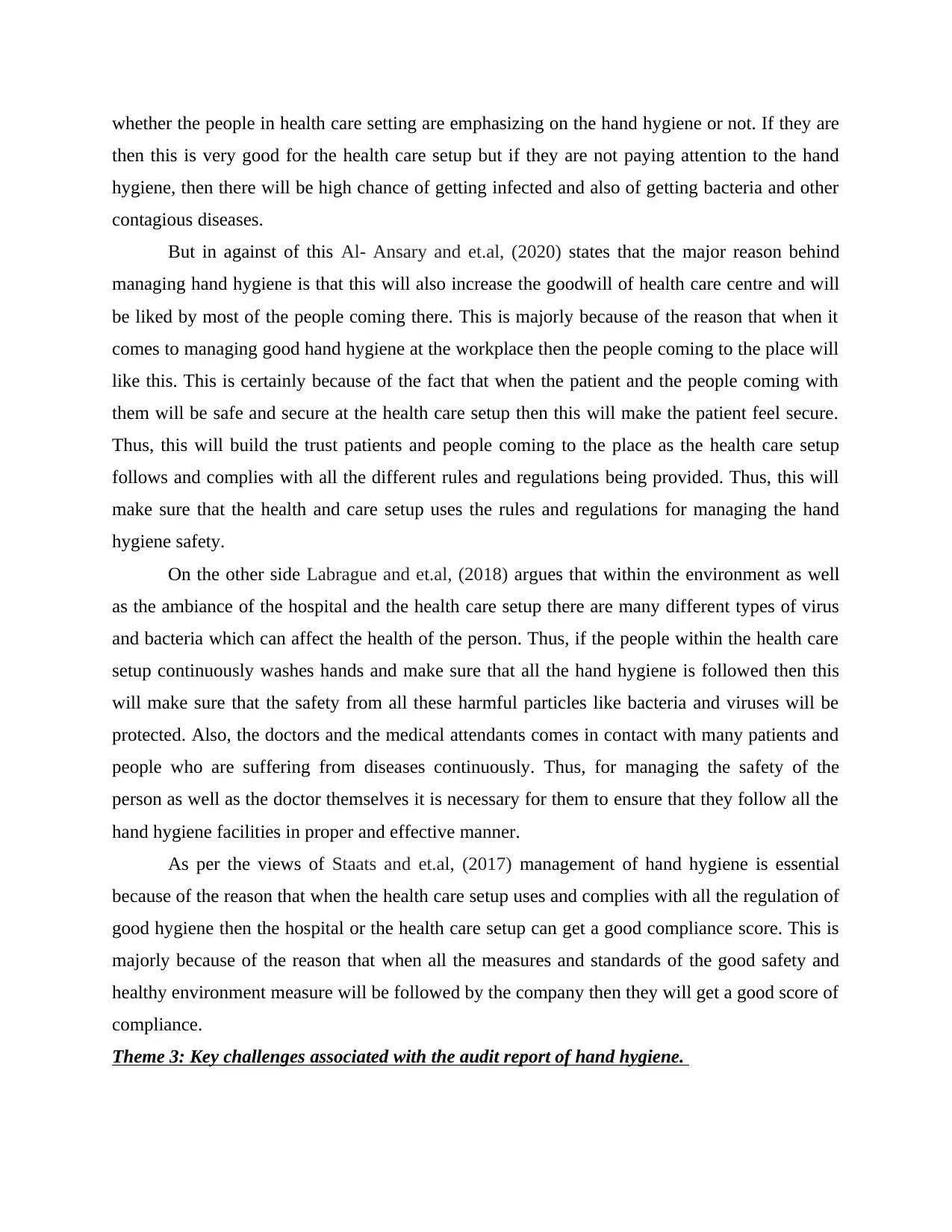
whether the people in health care setting are emphasizing on the hand hygiene or not. If they are
then this is very good for the health care setup but if they are not paying attention to the hand
hygiene, then there will be high chance of getting infected and also of getting bacteria and other
contagious diseases.
But in against of this Al- Ansary and et.al, (2020) states that the major reason behind
managing hand hygiene is that this will also increase the goodwill of health care centre and will
be liked by most of the people coming there. This is majorly because of the reason that when it
comes to managing good hand hygiene at the workplace then the people coming to the place will
like this. This is certainly because of the fact that when the patient and the people coming with
them will be safe and secure at the health care setup then this will make the patient feel secure.
Thus, this will build the trust patients and people coming to the place as the health care setup
follows and complies with all the different rules and regulations being provided. Thus, this will
make sure that the health and care setup uses the rules and regulations for managing the hand
hygiene safety.
On the other side Labrague and et.al, (2018) argues that within the environment as well
as the ambiance of the hospital and the health care setup there are many different types of virus
and bacteria which can affect the health of the person. Thus, if the people within the health care
setup continuously washes hands and make sure that all the hand hygiene is followed then this
will make sure that the safety from all these harmful particles like bacteria and viruses will be
protected. Also, the doctors and the medical attendants comes in contact with many patients and
people who are suffering from diseases continuously. Thus, for managing the safety of the
person as well as the doctor themselves it is necessary for them to ensure that they follow all the
hand hygiene facilities in proper and effective manner.
As per the views of Staats and et.al, (2017) management of hand hygiene is essential
because of the reason that when the health care setup uses and complies with all the regulation of
good hygiene then the hospital or the health care setup can get a good compliance score. This is
majorly because of the reason that when all the measures and standards of the good safety and
healthy environment measure will be followed by the company then they will get a good score of
compliance.
Theme 3: Key challenges associated with the audit report of hand hygiene.
then this is very good for the health care setup but if they are not paying attention to the hand
hygiene, then there will be high chance of getting infected and also of getting bacteria and other
contagious diseases.
But in against of this Al- Ansary and et.al, (2020) states that the major reason behind
managing hand hygiene is that this will also increase the goodwill of health care centre and will
be liked by most of the people coming there. This is majorly because of the reason that when it
comes to managing good hand hygiene at the workplace then the people coming to the place will
like this. This is certainly because of the fact that when the patient and the people coming with
them will be safe and secure at the health care setup then this will make the patient feel secure.
Thus, this will build the trust patients and people coming to the place as the health care setup
follows and complies with all the different rules and regulations being provided. Thus, this will
make sure that the health and care setup uses the rules and regulations for managing the hand
hygiene safety.
On the other side Labrague and et.al, (2018) argues that within the environment as well
as the ambiance of the hospital and the health care setup there are many different types of virus
and bacteria which can affect the health of the person. Thus, if the people within the health care
setup continuously washes hands and make sure that all the hand hygiene is followed then this
will make sure that the safety from all these harmful particles like bacteria and viruses will be
protected. Also, the doctors and the medical attendants comes in contact with many patients and
people who are suffering from diseases continuously. Thus, for managing the safety of the
person as well as the doctor themselves it is necessary for them to ensure that they follow all the
hand hygiene facilities in proper and effective manner.
As per the views of Staats and et.al, (2017) management of hand hygiene is essential
because of the reason that when the health care setup uses and complies with all the regulation of
good hygiene then the hospital or the health care setup can get a good compliance score. This is
majorly because of the reason that when all the measures and standards of the good safety and
healthy environment measure will be followed by the company then they will get a good score of
compliance.
Theme 3: Key challenges associated with the audit report of hand hygiene.
Paraphrase This Document
Need a fresh take? Get an instant paraphrase of this document with our AI Paraphraser
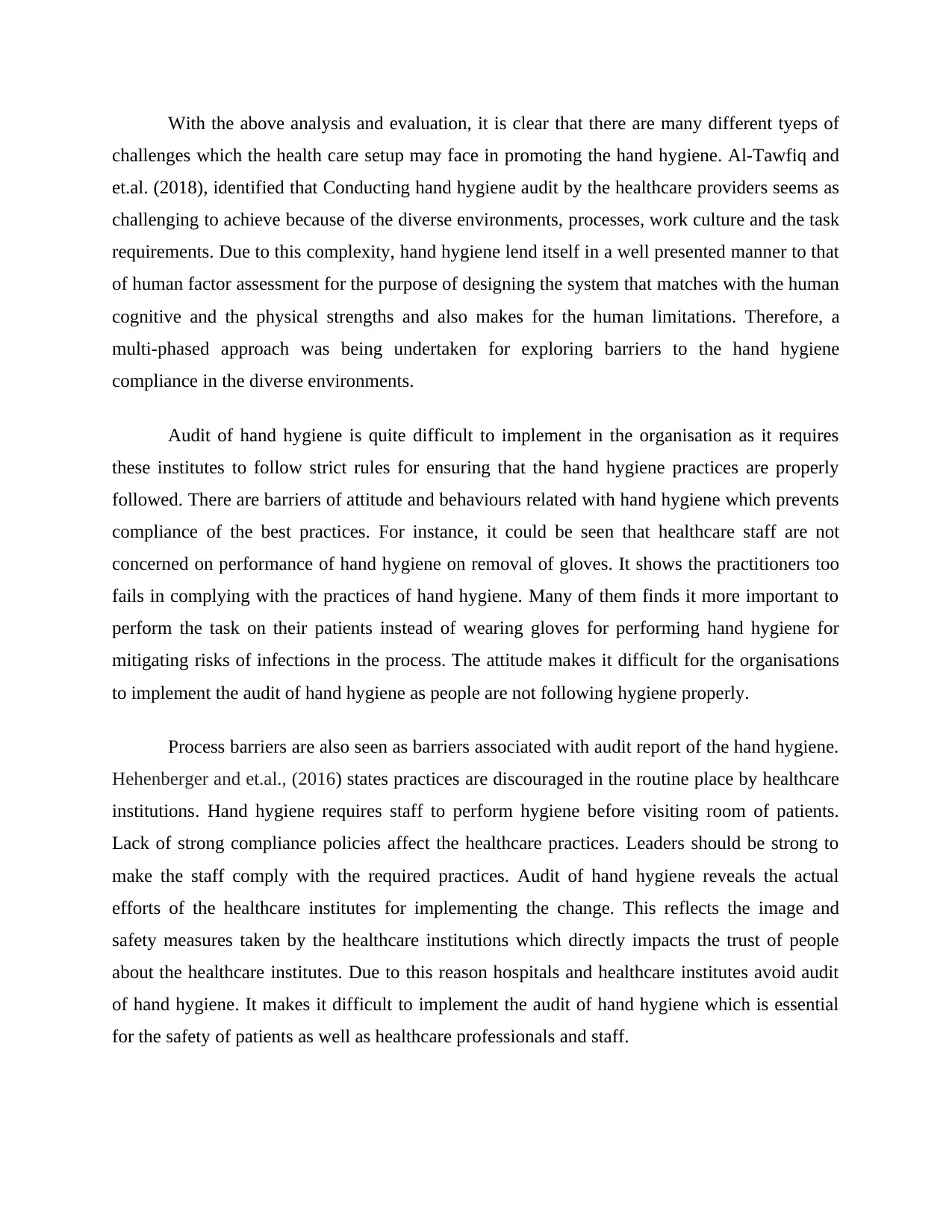
With the above analysis and evaluation, it is clear that there are many different tyeps of
challenges which the health care setup may face in promoting the hand hygiene. Al-Tawfiq and
et.al. (2018), identified that Conducting hand hygiene audit by the healthcare providers seems as
challenging to achieve because of the diverse environments, processes, work culture and the task
requirements. Due to this complexity, hand hygiene lend itself in a well presented manner to that
of human factor assessment for the purpose of designing the system that matches with the human
cognitive and the physical strengths and also makes for the human limitations. Therefore, a
multi-phased approach was being undertaken for exploring barriers to the hand hygiene
compliance in the diverse environments.
Audit of hand hygiene is quite difficult to implement in the organisation as it requires
these institutes to follow strict rules for ensuring that the hand hygiene practices are properly
followed. There are barriers of attitude and behaviours related with hand hygiene which prevents
compliance of the best practices. For instance, it could be seen that healthcare staff are not
concerned on performance of hand hygiene on removal of gloves. It shows the practitioners too
fails in complying with the practices of hand hygiene. Many of them finds it more important to
perform the task on their patients instead of wearing gloves for performing hand hygiene for
mitigating risks of infections in the process. The attitude makes it difficult for the organisations
to implement the audit of hand hygiene as people are not following hygiene properly.
Process barriers are also seen as barriers associated with audit report of the hand hygiene.
Hehenberger and et.al., (2016) states practices are discouraged in the routine place by healthcare
institutions. Hand hygiene requires staff to perform hygiene before visiting room of patients.
Lack of strong compliance policies affect the healthcare practices. Leaders should be strong to
make the staff comply with the required practices. Audit of hand hygiene reveals the actual
efforts of the healthcare institutes for implementing the change. This reflects the image and
safety measures taken by the healthcare institutions which directly impacts the trust of people
about the healthcare institutes. Due to this reason hospitals and healthcare institutes avoid audit
of hand hygiene. It makes it difficult to implement the audit of hand hygiene which is essential
for the safety of patients as well as healthcare professionals and staff.
challenges which the health care setup may face in promoting the hand hygiene. Al-Tawfiq and
et.al. (2018), identified that Conducting hand hygiene audit by the healthcare providers seems as
challenging to achieve because of the diverse environments, processes, work culture and the task
requirements. Due to this complexity, hand hygiene lend itself in a well presented manner to that
of human factor assessment for the purpose of designing the system that matches with the human
cognitive and the physical strengths and also makes for the human limitations. Therefore, a
multi-phased approach was being undertaken for exploring barriers to the hand hygiene
compliance in the diverse environments.
Audit of hand hygiene is quite difficult to implement in the organisation as it requires
these institutes to follow strict rules for ensuring that the hand hygiene practices are properly
followed. There are barriers of attitude and behaviours related with hand hygiene which prevents
compliance of the best practices. For instance, it could be seen that healthcare staff are not
concerned on performance of hand hygiene on removal of gloves. It shows the practitioners too
fails in complying with the practices of hand hygiene. Many of them finds it more important to
perform the task on their patients instead of wearing gloves for performing hand hygiene for
mitigating risks of infections in the process. The attitude makes it difficult for the organisations
to implement the audit of hand hygiene as people are not following hygiene properly.
Process barriers are also seen as barriers associated with audit report of the hand hygiene.
Hehenberger and et.al., (2016) states practices are discouraged in the routine place by healthcare
institutions. Hand hygiene requires staff to perform hygiene before visiting room of patients.
Lack of strong compliance policies affect the healthcare practices. Leaders should be strong to
make the staff comply with the required practices. Audit of hand hygiene reveals the actual
efforts of the healthcare institutes for implementing the change. This reflects the image and
safety measures taken by the healthcare institutions which directly impacts the trust of people
about the healthcare institutes. Due to this reason hospitals and healthcare institutes avoid audit
of hand hygiene. It makes it difficult to implement the audit of hand hygiene which is essential
for the safety of patients as well as healthcare professionals and staff.
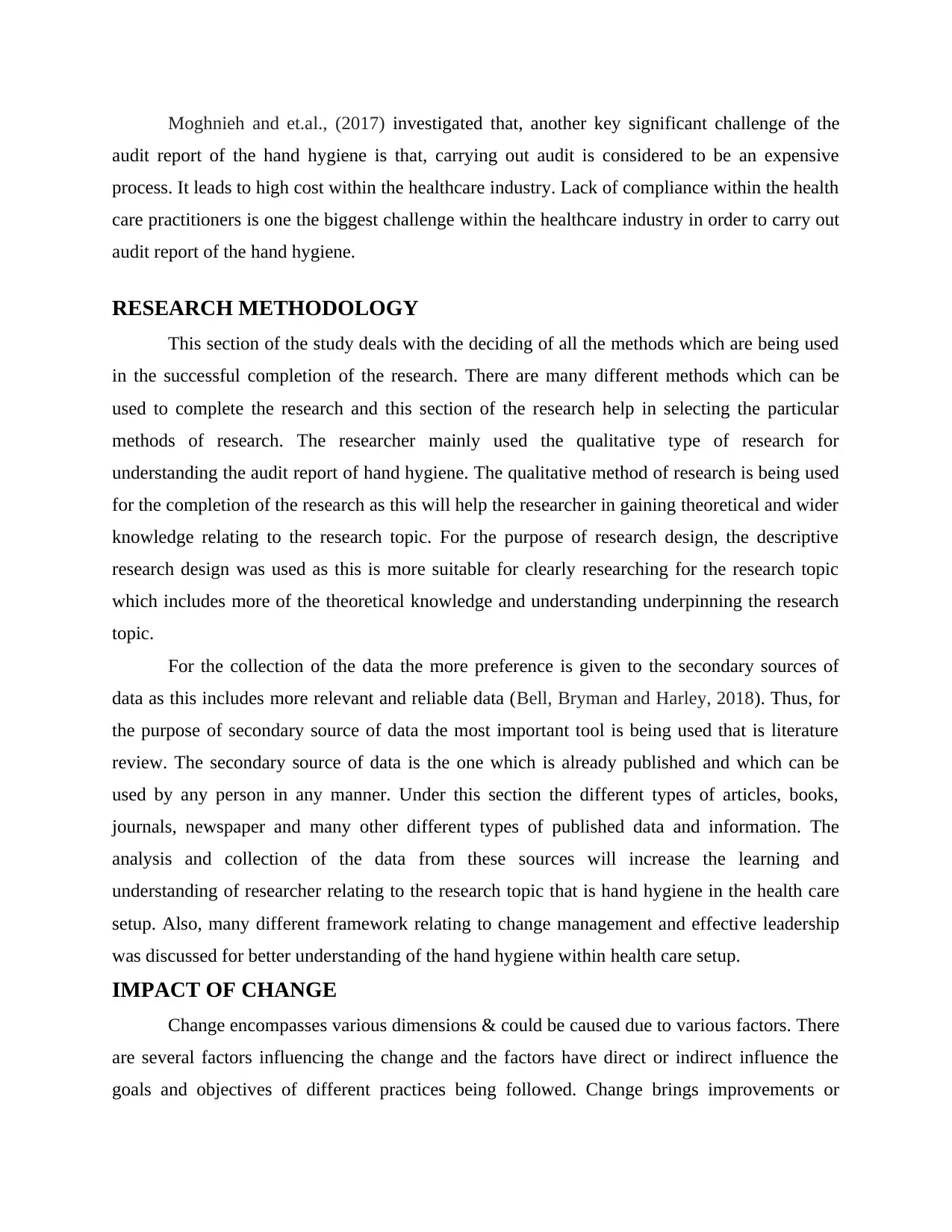
Moghnieh and et.al., (2017) investigated that, another key significant challenge of the
audit report of the hand hygiene is that, carrying out audit is considered to be an expensive
process. It leads to high cost within the healthcare industry. Lack of compliance within the health
care practitioners is one the biggest challenge within the healthcare industry in order to carry out
audit report of the hand hygiene.
RESEARCH METHODOLOGY
This section of the study deals with the deciding of all the methods which are being used
in the successful completion of the research. There are many different methods which can be
used to complete the research and this section of the research help in selecting the particular
methods of research. The researcher mainly used the qualitative type of research for
understanding the audit report of hand hygiene. The qualitative method of research is being used
for the completion of the research as this will help the researcher in gaining theoretical and wider
knowledge relating to the research topic. For the purpose of research design, the descriptive
research design was used as this is more suitable for clearly researching for the research topic
which includes more of the theoretical knowledge and understanding underpinning the research
topic.
For the collection of the data the more preference is given to the secondary sources of
data as this includes more relevant and reliable data (Bell, Bryman and Harley, 2018). Thus, for
the purpose of secondary source of data the most important tool is being used that is literature
review. The secondary source of data is the one which is already published and which can be
used by any person in any manner. Under this section the different types of articles, books,
journals, newspaper and many other different types of published data and information. The
analysis and collection of the data from these sources will increase the learning and
understanding of researcher relating to the research topic that is hand hygiene in the health care
setup. Also, many different framework relating to change management and effective leadership
was discussed for better understanding of the hand hygiene within health care setup.
IMPACT OF CHANGE
Change encompasses various dimensions & could be caused due to various factors. There
are several factors influencing the change and the factors have direct or indirect influence the
goals and objectives of different practices being followed. Change brings improvements or
audit report of the hand hygiene is that, carrying out audit is considered to be an expensive
process. It leads to high cost within the healthcare industry. Lack of compliance within the health
care practitioners is one the biggest challenge within the healthcare industry in order to carry out
audit report of the hand hygiene.
RESEARCH METHODOLOGY
This section of the study deals with the deciding of all the methods which are being used
in the successful completion of the research. There are many different methods which can be
used to complete the research and this section of the research help in selecting the particular
methods of research. The researcher mainly used the qualitative type of research for
understanding the audit report of hand hygiene. The qualitative method of research is being used
for the completion of the research as this will help the researcher in gaining theoretical and wider
knowledge relating to the research topic. For the purpose of research design, the descriptive
research design was used as this is more suitable for clearly researching for the research topic
which includes more of the theoretical knowledge and understanding underpinning the research
topic.
For the collection of the data the more preference is given to the secondary sources of
data as this includes more relevant and reliable data (Bell, Bryman and Harley, 2018). Thus, for
the purpose of secondary source of data the most important tool is being used that is literature
review. The secondary source of data is the one which is already published and which can be
used by any person in any manner. Under this section the different types of articles, books,
journals, newspaper and many other different types of published data and information. The
analysis and collection of the data from these sources will increase the learning and
understanding of researcher relating to the research topic that is hand hygiene in the health care
setup. Also, many different framework relating to change management and effective leadership
was discussed for better understanding of the hand hygiene within health care setup.
IMPACT OF CHANGE
Change encompasses various dimensions & could be caused due to various factors. There
are several factors influencing the change and the factors have direct or indirect influence the
goals and objectives of different practices being followed. Change brings improvements or
⊘ This is a preview!⊘
Do you want full access?
Subscribe today to unlock all pages.

Trusted by 1+ million students worldwide
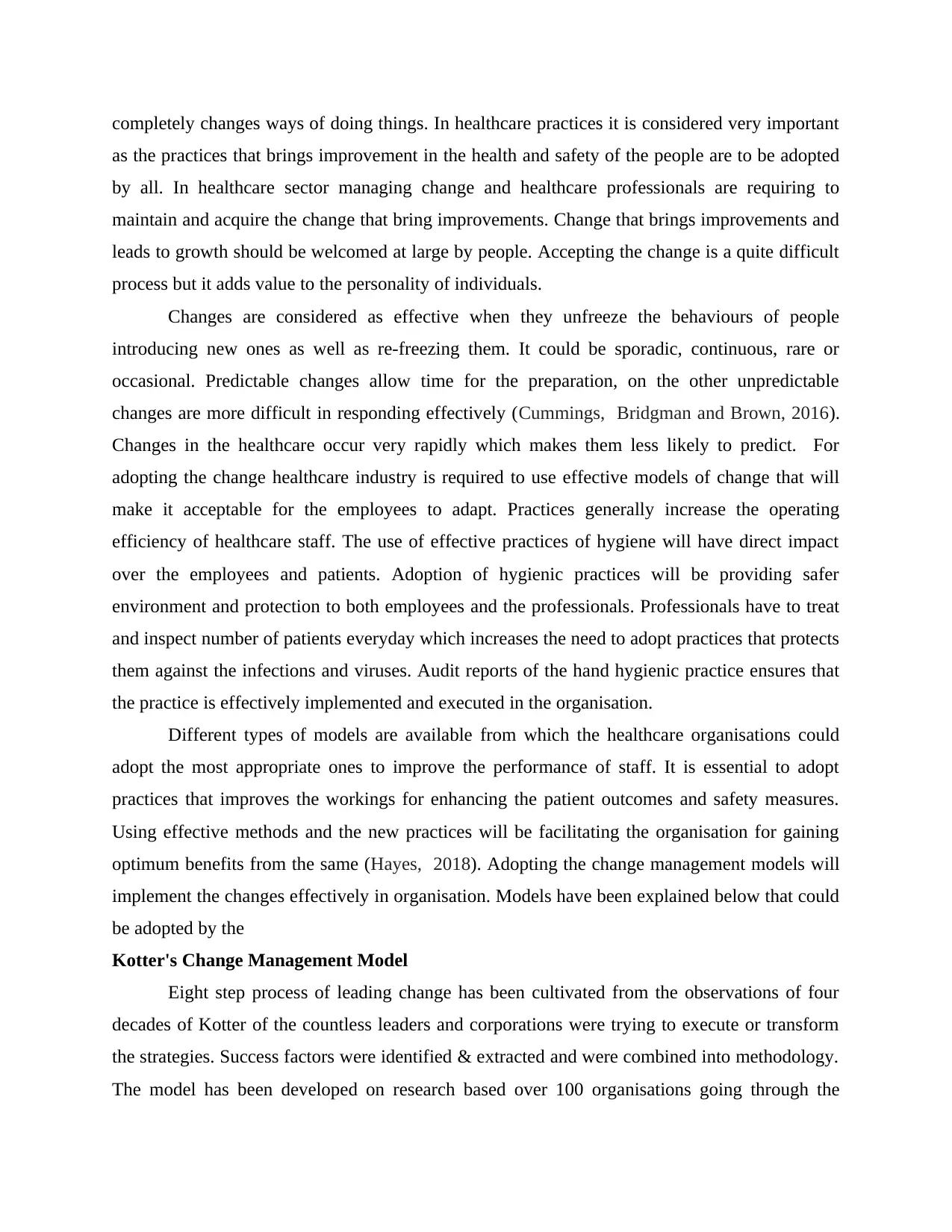
completely changes ways of doing things. In healthcare practices it is considered very important
as the practices that brings improvement in the health and safety of the people are to be adopted
by all. In healthcare sector managing change and healthcare professionals are requiring to
maintain and acquire the change that bring improvements. Change that brings improvements and
leads to growth should be welcomed at large by people. Accepting the change is a quite difficult
process but it adds value to the personality of individuals.
Changes are considered as effective when they unfreeze the behaviours of people
introducing new ones as well as re-freezing them. It could be sporadic, continuous, rare or
occasional. Predictable changes allow time for the preparation, on the other unpredictable
changes are more difficult in responding effectively (Cummings, Bridgman and Brown, 2016).
Changes in the healthcare occur very rapidly which makes them less likely to predict. For
adopting the change healthcare industry is required to use effective models of change that will
make it acceptable for the employees to adapt. Practices generally increase the operating
efficiency of healthcare staff. The use of effective practices of hygiene will have direct impact
over the employees and patients. Adoption of hygienic practices will be providing safer
environment and protection to both employees and the professionals. Professionals have to treat
and inspect number of patients everyday which increases the need to adopt practices that protects
them against the infections and viruses. Audit reports of the hand hygienic practice ensures that
the practice is effectively implemented and executed in the organisation.
Different types of models are available from which the healthcare organisations could
adopt the most appropriate ones to improve the performance of staff. It is essential to adopt
practices that improves the workings for enhancing the patient outcomes and safety measures.
Using effective methods and the new practices will be facilitating the organisation for gaining
optimum benefits from the same (Hayes, 2018). Adopting the change management models will
implement the changes effectively in organisation. Models have been explained below that could
be adopted by the
Kotter's Change Management Model
Eight step process of leading change has been cultivated from the observations of four
decades of Kotter of the countless leaders and corporations were trying to execute or transform
the strategies. Success factors were identified & extracted and were combined into methodology.
The model has been developed on research based over 100 organisations going through the
as the practices that brings improvement in the health and safety of the people are to be adopted
by all. In healthcare sector managing change and healthcare professionals are requiring to
maintain and acquire the change that bring improvements. Change that brings improvements and
leads to growth should be welcomed at large by people. Accepting the change is a quite difficult
process but it adds value to the personality of individuals.
Changes are considered as effective when they unfreeze the behaviours of people
introducing new ones as well as re-freezing them. It could be sporadic, continuous, rare or
occasional. Predictable changes allow time for the preparation, on the other unpredictable
changes are more difficult in responding effectively (Cummings, Bridgman and Brown, 2016).
Changes in the healthcare occur very rapidly which makes them less likely to predict. For
adopting the change healthcare industry is required to use effective models of change that will
make it acceptable for the employees to adapt. Practices generally increase the operating
efficiency of healthcare staff. The use of effective practices of hygiene will have direct impact
over the employees and patients. Adoption of hygienic practices will be providing safer
environment and protection to both employees and the professionals. Professionals have to treat
and inspect number of patients everyday which increases the need to adopt practices that protects
them against the infections and viruses. Audit reports of the hand hygienic practice ensures that
the practice is effectively implemented and executed in the organisation.
Different types of models are available from which the healthcare organisations could
adopt the most appropriate ones to improve the performance of staff. It is essential to adopt
practices that improves the workings for enhancing the patient outcomes and safety measures.
Using effective methods and the new practices will be facilitating the organisation for gaining
optimum benefits from the same (Hayes, 2018). Adopting the change management models will
implement the changes effectively in organisation. Models have been explained below that could
be adopted by the
Kotter's Change Management Model
Eight step process of leading change has been cultivated from the observations of four
decades of Kotter of the countless leaders and corporations were trying to execute or transform
the strategies. Success factors were identified & extracted and were combined into methodology.
The model has been developed on research based over 100 organisations going through the
Paraphrase This Document
Need a fresh take? Get an instant paraphrase of this document with our AI Paraphraser
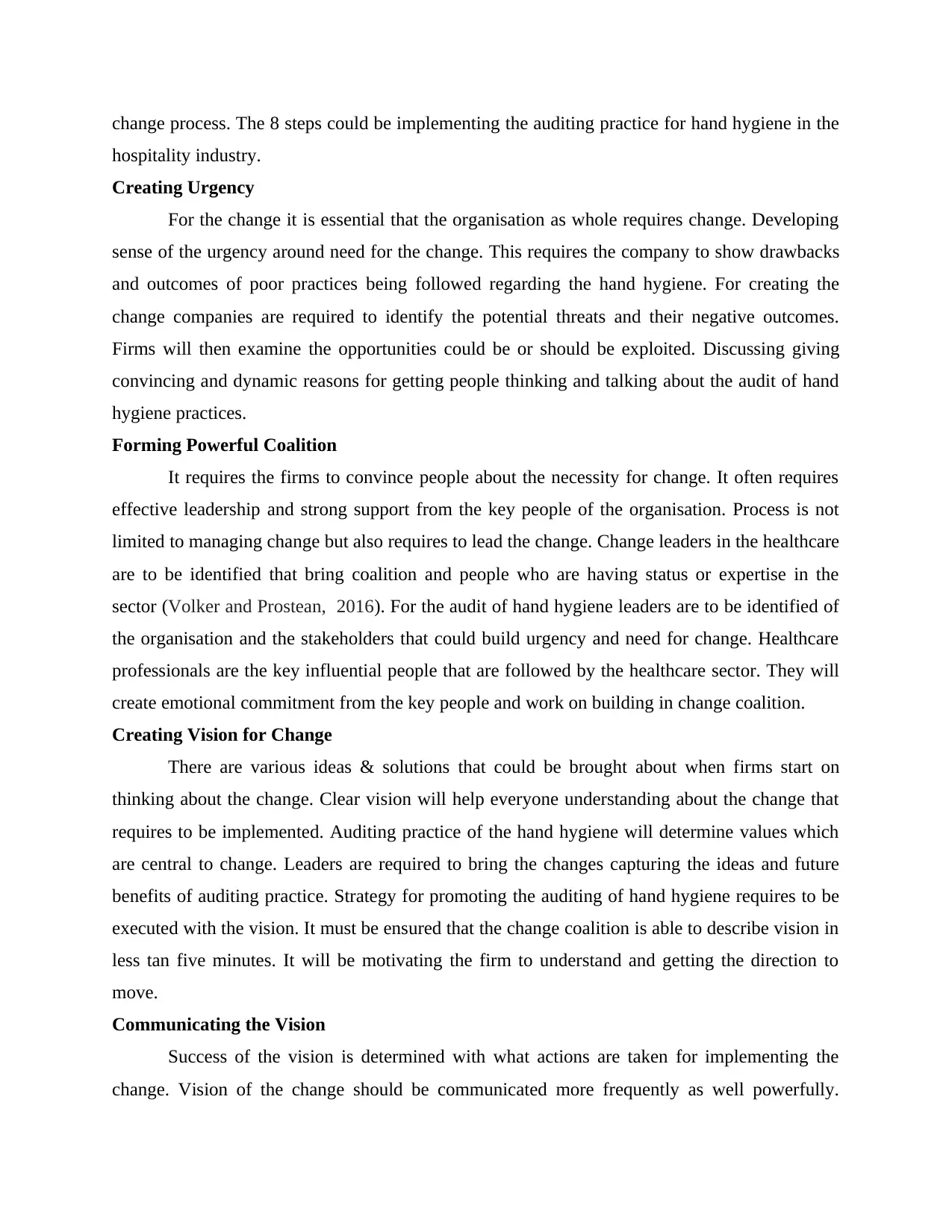
change process. The 8 steps could be implementing the auditing practice for hand hygiene in the
hospitality industry.
Creating Urgency
For the change it is essential that the organisation as whole requires change. Developing
sense of the urgency around need for the change. This requires the company to show drawbacks
and outcomes of poor practices being followed regarding the hand hygiene. For creating the
change companies are required to identify the potential threats and their negative outcomes.
Firms will then examine the opportunities could be or should be exploited. Discussing giving
convincing and dynamic reasons for getting people thinking and talking about the audit of hand
hygiene practices.
Forming Powerful Coalition
It requires the firms to convince people about the necessity for change. It often requires
effective leadership and strong support from the key people of the organisation. Process is not
limited to managing change but also requires to lead the change. Change leaders in the healthcare
are to be identified that bring coalition and people who are having status or expertise in the
sector (Volker and Prostean, 2016). For the audit of hand hygiene leaders are to be identified of
the organisation and the stakeholders that could build urgency and need for change. Healthcare
professionals are the key influential people that are followed by the healthcare sector. They will
create emotional commitment from the key people and work on building in change coalition.
Creating Vision for Change
There are various ideas & solutions that could be brought about when firms start on
thinking about the change. Clear vision will help everyone understanding about the change that
requires to be implemented. Auditing practice of the hand hygiene will determine values which
are central to change. Leaders are required to bring the changes capturing the ideas and future
benefits of auditing practice. Strategy for promoting the auditing of hand hygiene requires to be
executed with the vision. It must be ensured that the change coalition is able to describe vision in
less tan five minutes. It will be motivating the firm to understand and getting the direction to
move.
Communicating the Vision
Success of the vision is determined with what actions are taken for implementing the
change. Vision of the change should be communicated more frequently as well powerfully.
hospitality industry.
Creating Urgency
For the change it is essential that the organisation as whole requires change. Developing
sense of the urgency around need for the change. This requires the company to show drawbacks
and outcomes of poor practices being followed regarding the hand hygiene. For creating the
change companies are required to identify the potential threats and their negative outcomes.
Firms will then examine the opportunities could be or should be exploited. Discussing giving
convincing and dynamic reasons for getting people thinking and talking about the audit of hand
hygiene practices.
Forming Powerful Coalition
It requires the firms to convince people about the necessity for change. It often requires
effective leadership and strong support from the key people of the organisation. Process is not
limited to managing change but also requires to lead the change. Change leaders in the healthcare
are to be identified that bring coalition and people who are having status or expertise in the
sector (Volker and Prostean, 2016). For the audit of hand hygiene leaders are to be identified of
the organisation and the stakeholders that could build urgency and need for change. Healthcare
professionals are the key influential people that are followed by the healthcare sector. They will
create emotional commitment from the key people and work on building in change coalition.
Creating Vision for Change
There are various ideas & solutions that could be brought about when firms start on
thinking about the change. Clear vision will help everyone understanding about the change that
requires to be implemented. Auditing practice of the hand hygiene will determine values which
are central to change. Leaders are required to bring the changes capturing the ideas and future
benefits of auditing practice. Strategy for promoting the auditing of hand hygiene requires to be
executed with the vision. It must be ensured that the change coalition is able to describe vision in
less tan five minutes. It will be motivating the firm to understand and getting the direction to
move.
Communicating the Vision
Success of the vision is determined with what actions are taken for implementing the
change. Vision of the change should be communicated more frequently as well powerfully.
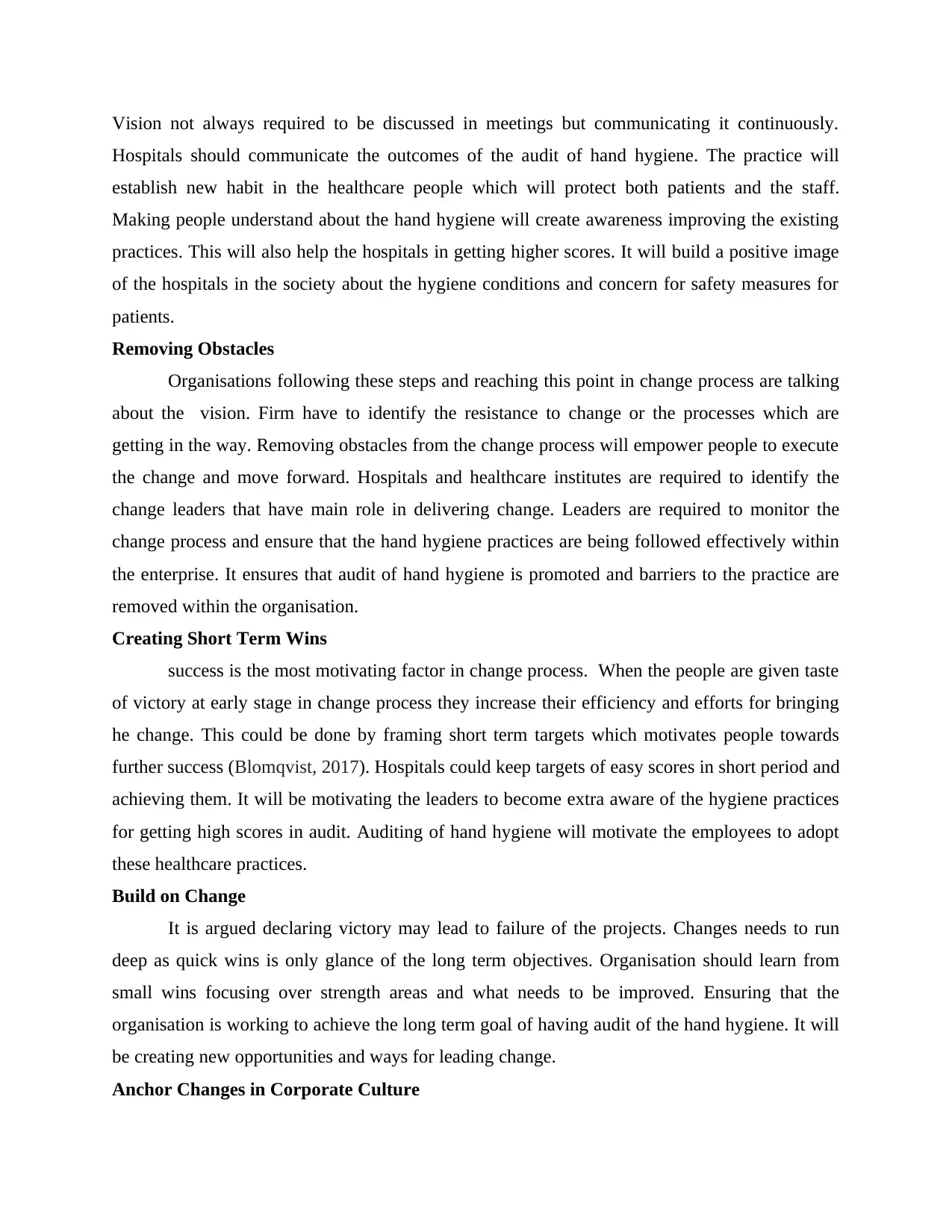
Vision not always required to be discussed in meetings but communicating it continuously.
Hospitals should communicate the outcomes of the audit of hand hygiene. The practice will
establish new habit in the healthcare people which will protect both patients and the staff.
Making people understand about the hand hygiene will create awareness improving the existing
practices. This will also help the hospitals in getting higher scores. It will build a positive image
of the hospitals in the society about the hygiene conditions and concern for safety measures for
patients.
Removing Obstacles
Organisations following these steps and reaching this point in change process are talking
about the vision. Firm have to identify the resistance to change or the processes which are
getting in the way. Removing obstacles from the change process will empower people to execute
the change and move forward. Hospitals and healthcare institutes are required to identify the
change leaders that have main role in delivering change. Leaders are required to monitor the
change process and ensure that the hand hygiene practices are being followed effectively within
the enterprise. It ensures that audit of hand hygiene is promoted and barriers to the practice are
removed within the organisation.
Creating Short Term Wins
success is the most motivating factor in change process. When the people are given taste
of victory at early stage in change process they increase their efficiency and efforts for bringing
he change. This could be done by framing short term targets which motivates people towards
further success (Blomqvist, 2017). Hospitals could keep targets of easy scores in short period and
achieving them. It will be motivating the leaders to become extra aware of the hygiene practices
for getting high scores in audit. Auditing of hand hygiene will motivate the employees to adopt
these healthcare practices.
Build on Change
It is argued declaring victory may lead to failure of the projects. Changes needs to run
deep as quick wins is only glance of the long term objectives. Organisation should learn from
small wins focusing over strength areas and what needs to be improved. Ensuring that the
organisation is working to achieve the long term goal of having audit of the hand hygiene. It will
be creating new opportunities and ways for leading change.
Anchor Changes in Corporate Culture
Hospitals should communicate the outcomes of the audit of hand hygiene. The practice will
establish new habit in the healthcare people which will protect both patients and the staff.
Making people understand about the hand hygiene will create awareness improving the existing
practices. This will also help the hospitals in getting higher scores. It will build a positive image
of the hospitals in the society about the hygiene conditions and concern for safety measures for
patients.
Removing Obstacles
Organisations following these steps and reaching this point in change process are talking
about the vision. Firm have to identify the resistance to change or the processes which are
getting in the way. Removing obstacles from the change process will empower people to execute
the change and move forward. Hospitals and healthcare institutes are required to identify the
change leaders that have main role in delivering change. Leaders are required to monitor the
change process and ensure that the hand hygiene practices are being followed effectively within
the enterprise. It ensures that audit of hand hygiene is promoted and barriers to the practice are
removed within the organisation.
Creating Short Term Wins
success is the most motivating factor in change process. When the people are given taste
of victory at early stage in change process they increase their efficiency and efforts for bringing
he change. This could be done by framing short term targets which motivates people towards
further success (Blomqvist, 2017). Hospitals could keep targets of easy scores in short period and
achieving them. It will be motivating the leaders to become extra aware of the hygiene practices
for getting high scores in audit. Auditing of hand hygiene will motivate the employees to adopt
these healthcare practices.
Build on Change
It is argued declaring victory may lead to failure of the projects. Changes needs to run
deep as quick wins is only glance of the long term objectives. Organisation should learn from
small wins focusing over strength areas and what needs to be improved. Ensuring that the
organisation is working to achieve the long term goal of having audit of the hand hygiene. It will
be creating new opportunities and ways for leading change.
Anchor Changes in Corporate Culture
⊘ This is a preview!⊘
Do you want full access?
Subscribe today to unlock all pages.

Trusted by 1+ million students worldwide
1 out of 21
Related Documents
Your All-in-One AI-Powered Toolkit for Academic Success.
+13062052269
info@desklib.com
Available 24*7 on WhatsApp / Email
![[object Object]](/_next/static/media/star-bottom.7253800d.svg)
Unlock your academic potential
Copyright © 2020–2025 A2Z Services. All Rights Reserved. Developed and managed by ZUCOL.





